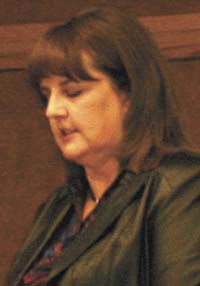| Deb Dull from Rocky Mountain Power reports to the commission. |
Rich Walje, president of Rocky Mountain Power addressed the Utah Association of Energy Users in December. He spoke about the increased costs of energy production. He told how Rocky Mountain Power is dealing with increased energy needs in Utah and surrounding states. Increase is driven by load growth, increased resource investment and new power costs. Load growth is a growing issue, the state’s population has grown by approximately 17 percent since the year 2000. Load forecasts anticipate Utah energy requirements will grow by 2.3 percent per year with the summer peak rising at an even faster rate.
By June 2009, Rocky Mountain Power will invest $2.7 billion in new total company investment which will be added beyond the level included in the last general rate case.
The cost to generate power has increased to $1.091 billion from $811 million in the last rate case. The expenses which are controllable like pension, benefits and other employee costs and maintenance have remained relatively flat.
The fastest growing states between July of 2005 to July 2006 was number one Arizona, second, Nevada, third Idaho, fourth Georgia, fifth Texas and the sixth fastest growing state is Utah with a growth rate of 2.4 percent.
Peak load growth and base load growth is expected to continue growing. Baseload growth is 1.7 percent and peak load growth is approximately 4 percent.
The sources for electric energy production in Utah has grown substantially since the early 1970s. Huntington was the first to come on line, Hunter, Bonanza, Intermountain, Gadsby Repower, Gadsby and West Valley and Currant Creek and Lakeside more recently.
The Blundell geothermal power unit was added in 1984 and generates 23 megawatts, 11 MW were added to this unit in 2007.
Gadsby, re-power from coal to natural gas generates 235 MW; the Foote Creek Unit in Wyoming generates 33 MW and came online in 1997. Gadsby, simple cycle natural gas generation-120 MW and came online in 2002.
The West Valley lease, simple cycle natural gas generates 540 MW since 2002. Currant Creek, combined cycle natural gas, 540 MW since 2005-06. The Lakeside, combined cycle natural gas, generates 540 MW and came online in 2007. Various wind projects since 2000 generate 440 MW. There have been no new coal fired units; Rocky Mountain Power lists permitting as an issue with coal fired units.
In generation capacity, coal makes up 54.7 percent; natural gas makes up 20.1 percent; non renewable purchased capacity-7.7 percent; hydropower 12.1 percent; wind power-3.9 percent, biogas-geothermal, 1.5 percent. Approximately 17.5 percent renewable capacity using the company’s proposed legislation.
Renewables on the way include: Blundell, geothermal, 11 MW, upgrade on line; Seven Mile Hill, wind, 99 MW in 2008; Glenrock, wind 99 MW, 2008; Goodnoe Hills, wind, 94 MW 2007-2008; Rolling Hills, wind, 99 MW, 2008.
Rocky Mountain Power’s current average generation costs is $35/MWh. These costs are significantly lower than the California Central Station Generation Technologies, Draft Staff Report where costs can average $140/MWh.
Rocky Mountain Power sees generation project cost drivers to include: labor shortages, driven by an aging workforce and demand, are likely for skilled craft and engineering roles, which will drive up labor costs; commodities and equipment are part of a global market, and global demand; fewer domestic equipment manufacturers, more international sources; fuel costs are increasingly uncertain, driven by demand and policy; a limited number of qualified contractors exists, siting and permitting requirements; not in my backyard syndrome.
Steel prices have risen from $425 per ton in 2000 to $893 per ton in 2007. The cost of a wind turbine in 2003 was $1 million per turbine; 2006-$2 million per turbine and an expected 8 percent increase in that cost by 2009.
Total company net power costs have increased from $811 million in the last rate case to $1.091 billion. Increased costs are due to retail load growth, increased coal costs, increased natural gas costs, expiration of purchase power contracts that are below current market prices.
Rocky Mountain Power has an authorized return on equity of approximately 12 percent. Since 1998 their actual return on equity has been significantly lower. It was near 11 percent in 1998 and by 1999 it had dropped to near 6 percent where it has stayed with slight dips until 2007 when Rocky Mountain Power requested a rate increase in December.
Rate increases would increase a residential customer charge to $4. It would implement a customer load charge of $6 per month for usage over 1,000 kWh per month.
Rate increases would maintain existing on/off peak differential for summer and winter it would uniformly increase demand and energy charges.
Utah is one of 11 states with average residential rates of cents per kilowatt hour of 8 cents or less. The Rocky Mountain Power average rate is 5.69 percent. California utilities average was 13.13 cents per kilowatt hour.
Deb Dull from Rocky Mountain Power reported to the Emery County Commissioners. She said an 11.3 percent rate increase has been asked for with the utility commission. Dull said that we are not in an environment right now that likes black energy. The trend is toward green energy and Rocky Mountain Power is growing in renewables. They are also taking a look at nuclear energy.
Rocky Mountain Power will put $850 million into wind power in 2008 for a total of 367.2 MW. By 2010, 1,400 megawatts of power will come from renewables with a goal of 2,000 MW by 2013.

